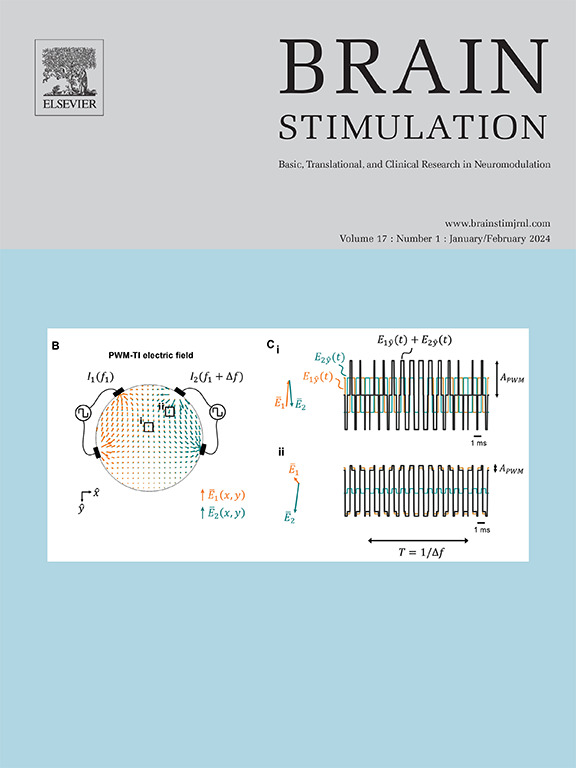Basal forebrain activation improves working memory in senescent monkeys
IF 7.6
1区 医学
Q1 CLINICAL NEUROLOGY
引用次数: 0
Abstract
Brain aging contributes to cognitive decline and risk of dementia. Degeneration of the basal forebrain cholinergic system parallels these changes in aging, Alzheimer's dementia, Parkinson's dementia, and Lewy body dementia, and thus is a common element linked to executive function across the lifespan and in disease states. Here, we tested the potential of one-hour daily intermittent basal forebrain stimulation to improve cognition in senescent Rhesus monkeys, and its mechanisms of action. Stimulation in five animals improved working memory duration in each animal over 8–12 weeks, with peak improvements observed in the first four weeks. In an ensuing three month period without stimulation, improvements were retained. With additional stimulation, performance remained above baseline throughout the 15 months of the study. Studies with a cholinesterase inhibitor in five animals produced inconsistent improvements in behavior. One of five animals improved significantly. Manipulating the stimulation pattern demonstrated selectivity for both stimulation and recovery period duration in two animals. Brain stimulation led to acute increases in cerebrospinal fluid levels of tissue plasminogen activator, which is an activating element for two brain neurotrophins, Nerve Growth Factor (NGF) and Brain-Derived Growth Factor (BDNF), in four animals. Stimulation also led to improved glucose utilization in stimulated hemispheres relative to contralateral in three animals. Glucose utilization also consistently declines with aging and some dementias. Together, these findings suggest that intermittent stimulation of the nucleus basalis of Meynert improves executive function and reverses some aspects of brain aging.
基底前脑激活改善衰老猴子的工作记忆
大脑老化会导致认知能力下降和患痴呆症的风险。基底前脑胆碱能系统的退化与衰老、阿尔茨海默氏痴呆、帕金森痴呆和路易体痴呆的这些变化相似,因此是与整个生命周期和疾病状态的执行功能相关的共同因素。在这里,我们测试了每天1小时间歇性基底前脑刺激改善衰老恒河猴认知能力的潜力及其作用机制。在8-12周的时间里,对5只动物的刺激改善了每只动物的工作记忆持续时间,在前四周观察到最大的改善。在随后的3个月没有增产措施的情况下,仍保持了增产效果。在15个月的研究中,通过额外的增产措施,作业性能保持在基线以上。在五只动物身上使用胆碱酯酶抑制剂的研究产生了不一致的行为改善。5只动物中有1只明显改善。在两种动物中,操纵刺激模式显示了对刺激和恢复期持续时间的选择性。脑刺激导致4只动物脑脊液组织纤溶酶原激活剂水平急剧升高,该激活剂是两种脑神经营养因子,神经生长因子(NGF)和脑源性生长因子(BDNF)的激活元素。在三种动物中,刺激也导致受刺激半球相对于对侧半球葡萄糖利用的改善。葡萄糖利用率也随着衰老和某些痴呆症而持续下降。综上所述,这些发现表明间歇性刺激Meynert基底核可以改善执行功能并逆转大脑衰老的某些方面。
本文章由计算机程序翻译,如有差异,请以英文原文为准。
求助全文
约1分钟内获得全文
求助全文
来源期刊

Brain Stimulation
医学-临床神经学
CiteScore
13.10
自引率
9.10%
发文量
256
审稿时长
72 days
期刊介绍:
Brain Stimulation publishes on the entire field of brain stimulation, including noninvasive and invasive techniques and technologies that alter brain function through the use of electrical, magnetic, radiowave, or focally targeted pharmacologic stimulation.
Brain Stimulation aims to be the premier journal for publication of original research in the field of neuromodulation. The journal includes: a) Original articles; b) Short Communications; c) Invited and original reviews; d) Technology and methodological perspectives (reviews of new devices, description of new methods, etc.); and e) Letters to the Editor. Special issues of the journal will be considered based on scientific merit.
 求助内容:
求助内容: 应助结果提醒方式:
应助结果提醒方式:


